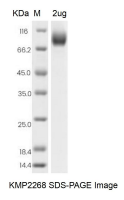Service Line:+86-022-82164980
Address:FL-4, Building A5, International Enterprise Community, Tianjin, China
Email:[email protected]
| Catalog Number | KMP2268 |
|---|---|
| Product Name | Human ANGPTL4 Protein, His Tag |
| Product Description | The Human ANGPTL4 Protein(KMP2268) is produced in HEK293 Cells and the target gene encoding Pro166-Ser406 is expressed with a 6His tag at the N-terminus. |
| Molecular Weight | 27.91 kDa |
| Alias | Angiopoietin-related protein 4, 425O18-1, Angiopoietin-like protein 4, ANGPTL4 |
| Species | Human |
| Host | HEK293 Cells |
| Size | 50ug, 100ug, 200ug |
| Purification | Affinity purification |
| Purity | >95% as determined by SDS-PAGE |
| Endotoxin | <1.0 EU/ug determined by the LAL method |
| Buffer | PBS, pH7.4 |
| Uniprot | Q9BY76 |
| SDS-PAGE |  |
| Function | 1.Mediates inactivation of the lipoprotein lipase LPL, and thereby plays a role in the regulation of triglyceride clearance from the blood serum and in lipid metabolism. 2.May also play a role in regulating glucose homeostasis and insulin sensitivity (Probable). Inhibits proliferation, migration, and tubule formation of endothelial cells and reduces vascular leakage. 3.Upon heterologous expression, inhibits the adhesion of endothelial cell to the extracellular matrix (ECM), and inhibits the reorganization of the actin cytoskeleton, formation of actin stress fibers and focal adhesions in endothelial cells that have adhered to ANGPTL4-containing ECM (in vitro). 4.Depending on context, may modulate tumor-related angiogenesis (By similarity). |
| Background | Angiopoietin-related protein 4(ANGPTL4)is a secreted protein and contains 1 fibrinogen C-terminal domain. The protein may act as a regulator of angiogenesis and modulate tumorigenesis. It inhibits proliferation, migration, and tubule formation of endothelial cells and reduces vascular leakage. ANGPTL4 may exert a protective function on endothelial cells through an endocrine action. It is directly involved in regulating glucose homeostasis, lipid metabolism, and insulin sensitivity(By similarity). In response to hypoxia, the unprocessed form of the protein accumulates in the subendothelial extracellular matrix(ECM). The matrix-associated and immobilized unprocessed form limits the formation of actin stress fibers and focal contacts in the adhering endothelial cells and inhibits their adhesion. It also decreases motility of endothelial cells and inhibits the sprouting and tube formation. |
| Storage | Aliquot and store at -20℃ to -80℃. Avoid repeated freezing and thawing cycles. |
| Note | This product is for research use only. |
| References | 1.Cancer Res. 63:6651-6657 (2003) 2.Circ. Res. 99:1207-1215 (2006) 3.J. Biol. Chem. 284:13213-13222 (2009) 4.J. Biol. Chem. 286:15747-15756 (2011) 5.Elife 5:0-0 (2016) 6.Proc. Natl. Acad. Sci. U.S.A. 115:E6020-E6029 (2018) 7.Nat. Commun. 9:2252-2252 (2018) |